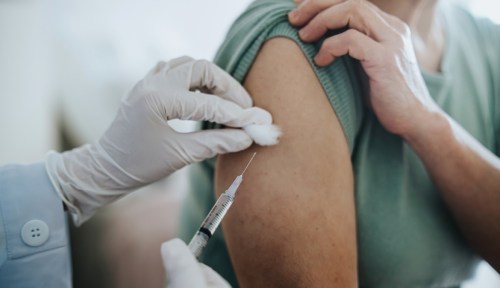Our editors independently select these products. Making a purchase through our links may earn Well+Good a commission
What You Need To Know About Titanium Dioxide in Pads and Tampons
Worried about titanium dioxide in tampons? Here's what experts want you to know about the ingredient that's getting heat on TikTok and beyond.

Recently, titanium dioxide (TiO2), a white powder used in tampons and other menstrual products, has been getting some serious heat. Claims that the tampon ingredient may be harmful come fresh on the heels of a buzzy lawsuit against Skittles (and its parent company, Mars Inc.) declaring TiO2 “unfit for human consumption.” Now, people on TikTok and elsewhere are questioning whether titanium dioxide belongs in tampons and pads, too.
Experts in This Article
fertility specialist and founder of the TUSHY method of egg fertilization
former nurse practitioner working with Favor (previously The Pill Club), a birth control delivery service and current program manager at Midi Health
“Titanium dioxide is the naturally occurring compound created when titanium reacts with oxygen in the air,” explains endocrinologist and advisor at reproductive-health company Natalist Aimee Eyvazzadeh, MD. “As an oxide, titanium is found in minerals in the earth’s crust and is also found with other elements, including calcium and iron.”
The U.S. Food and Drug Administration (FDA) approved titanium dioxide for human consumption in 1966, cementing its presence in a variety of foods, including candies and other processed foods. It’s primarily used to help make white foods appear whiter (like milk and candy) or to lengthen the shelf life of foods that are sensitive to UV light. (The FDA says that manufacturers can have no more than 1 percent TiO2 in food.)
However, trouble arose for the ingredient in 2021 when the European Food Safety Authority (EFSA) issued a statement that titanium dioxide “could no longer be considered safe” as a food additive. In its report, the EFSA reported that they couldn’t rule out the possibility that titanium dioxide caused damage to DNA (“genotoxicity”)—and thus couldn’t establish a safe level of daily intake. This finding prompted the European Union to ban TiO2 as a food additive earlier this year, but in the U.S., the ingredient is still considered to be safe in food at the limits set by the FDA.
However, titanium dioxide isn’t just a popular ingredient in food. It also appears in sunscreen and cosmetics, two categories in which the ingredient is also generally considered safe. It’s also is often used to make things like paint, and most relevant for our purposes, it’s used to make pads and tampons appear whiter.
It’s unclear exactly how many brands use TiO2 in their menstrual products. The FDA classifies tampons and pads as medical devices, and thus manufacturers of these products are recommended, but not required, to list their ingredients. (That’s slowly changing after New York passed a law requiring ingredients lists on menstrual products sold in the state). That said, well-known brands like Tampax and L. include TiO2 in their products, while brands like Rael, Cora, and The Honey Pot currently do not have this ingredient in their pads or tampons.
So the million-dollar question: is it safe to have titanium dioxide in pads and tampons? Below, Dr. Eyvazzadeh and Erin Flynn, MPH, DNP/FNP, an LGBTQ+ care expert with birth control startup Favor, share the complicated truth behind this question. Just bear in mind: If you have any specific health concerns to weigh, it’s critical to reach out to your gynecologist or primary care physician to make the right choice for you.
What are the potential adverse health effects of titanium dioxide?
One of the tricky things about titanium dioxide is that it can be consumed in a myriad of ways, making risk calculation difficult. “The potential risks of titanium dioxide vary depending on the method of exposure,” says Dr. Eyvazzadeh. Inhaling titanium dioxide while you’re painting a room or working on a construction site, for example, may irritate the eyes, nose, and throat. But there’s not much research to tell us what the potential effects are of TiO2 in certain other formats, like if you eat a little bit of it in food, or regularly insert small amounts of it in your body via a tampon for a few days each month.
“There is no published research available currently that has examined the impacts of vaginal or vulvar exposure to titanium dioxide.” —Aimee Eyvazzadeh, MD
There is some evidence to suggest that titanium dioxide may have a carcinogenic effect in some formats. “[TiO2] may cause cancer based on studies done on animals, and it has been associated with lung cancer when inhaled,” says Dr. Eyvazzadeh, which is why the government sets limits on exposure for workers. Other human studies, however, have not found any clear link between lung cancer and titanium dioxide. And there honestly isn’t a ton of reliable data on the ingredient to help us draw better conclusions, argues the authors of this 2011 review.
There’s also a little bit of evidence to suggest that the common ingredient may be an endocrine disruptor, says Flynn—meaning it may affect a person’s hormonal system. “[P]revious studies have shown that titanium dioxide can cause alterations to the reproductive system, including reducing the ovarian follicles and leading to the formation of ovarian cysts,” she says. However, these studies were conducted on mice who orally consumed titanium dioxide, so we’ll still need extensive clinical research on humans before we can definitively link TiO2 with reproductive disruption—or assume those risks definitely come from other intakes of the ingredient.
As for the potential risks (or lack thereof!) of using pads and tampons with titanium dioxide…we just don’t know for certain. “There is no published research available currently that has examined the impacts of vaginal or vulvar exposure to titanium dioxide,” Dr. Eyvazzadeh. “But while no study has positively linked titanium dioxide exposure to ovarian cancer, miscarriages, or UTIs, we also don’t have the science to assure us that this kind of exposure is perfectly safe either.” This lack of data is incredibly frustrating, given that 26 percent of the global population are of reproductive age and presumably using pads and tampons on the regular to manage their cycles.
What this means for the titanium dioxide found in menstrual products—and how to make a conscious purchasing decision next time you stock up
Because there’s so little conclusive research on the potential effects of titanium dioxide, you’re not going to find clear, concise guidance for tampon shopping by studying up. So what do you do instead?
Some experts say that there’s no need to lose sleep over having titanium dioxide in tampons. “If this worries you, then don’t use products that have this,” Jennifer Lincoln, MD, shared in a video. “But it’s the dose, it’s the route that makes the ‘poison,’ and so just because something might cause lung cancer, for example, doesn’t mean it’s going to cause an issue in a tampon.”
Dr. Eyvazzadeh and Flynn agree that it’s okay to approach the ingredient with caution. “If you feel uncomfortable with the potential risks associated with titanium dioxide, look for products that don’t include titanium dioxide on the ingredients list,” says Flynn. “While most cosmetic products will disclose whether or not titanium dioxide is an ingredient—some states require it—it is important to note that the FDA does not currently require brands to disclose this information.”
Fortunately, many new wave period-care companies are extremely transparent about their ingredients lists. As a result, it’s not too difficult to shop for TiO2-free tampons if you’re concerned—and have the financial means to do so. It’s also worth being skeptical of any definitive claims that titanium dioxide in tampons is super harmful. As Dr. Eyvazzadeh points out, we just don’t know either way—no matter how certain Becky on TikTok seems.
Sign Up for Our Daily Newsletter
Get all the latest in wellness, trends, food, fitness, beauty, and more delivered right to your inbox.
Got it, you've been added to our email list.










